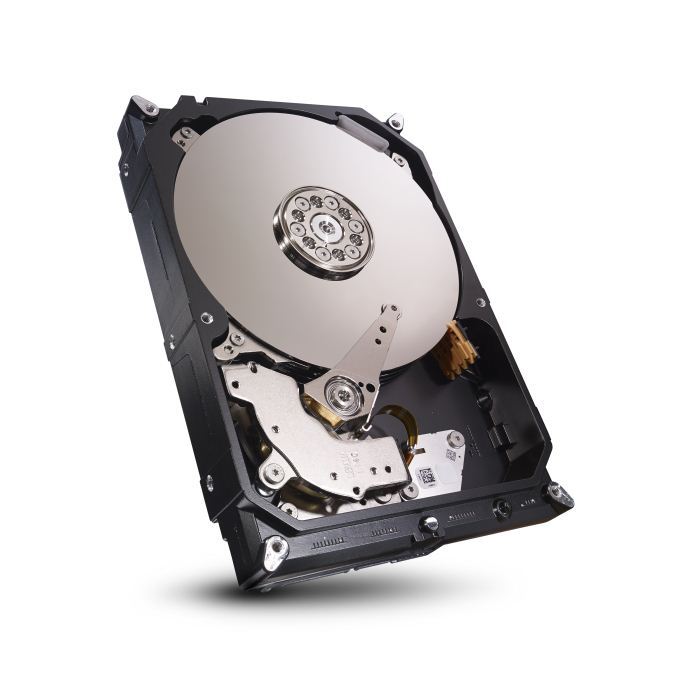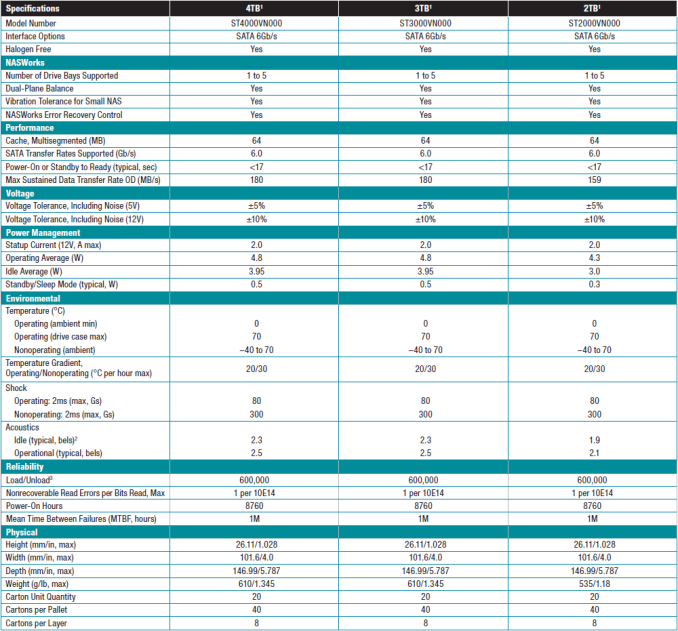Seagate Introduces NAS HDD: WD Red Gets a Competitor
by Ganesh T S on June 11, 2013 8:01 AM EST- Posted in
- NAS
- Storage
- Seagate
- Enterprise
Consumers looking to fill their SOHO / consumer NAS units with hard drives haven't had too many choices. Western Digital recognized early on that the dwindling HDD sales in the PC arena had to be made up for in the fast growing NAS segment. Towards this, they introduced the WD Red series (in 1TB, 2TB and 3TB capacities) last July. Today, Seagate is responding with their aptly named NAS HDD lineup. Just like the WD Red, these HDDs are targeted towards 1- to 5-bay NAS units. WD terms their firmware secret sauce as NASWare and Seagate's is NASWorks. NASWorks supports customized error recovery controls (TLER in other words), power management and vibration tolerance.
TLER helps to ensure that drives don't get dropped from the NAS and send the array into a rebuild phase. Seagate also claims that the firmware has an optimal balance for sequential and random performance.
Seagate does have a lead over WD in the capacity department. While the WD Red currently tops out at 3TB, Seagate's NAS HDD comes in 2 TB, 3 TB and 4 TB flavors. Seagate hasn't provided any information on the number of platters or spindle speed. Power consumption numbers are available, though. Average operating power is 4.3W for the 2TB model and 4.8W for the 3 TB and 4 TB ones.
Pricing is set at $126, $168 and $229 for the 2TB, 3TB and 4TB models respectively.
Update: Seagate has released an extensive product manual here. The 3TB and 4TB models have four platters each, while the 2TB model has two. The drives have a 3-year warranty.
Source: Seagate












46 Comments
View All Comments
bsd228 - Wednesday, June 12, 2013 - link
if you look at the non NAS models, they list 2400 hours. This figure is what they suggest should be the annual usage (8 hours per day) for the claimed reliability. It's a goofy spec to list. You can (and I do) read that as a lack of confidence in running it 7x24. With this new line, they're giving an annual use expectation of 7x24. I have been waiting for a 4tb Red. We'll see if it exists by the time I next need some drives. Currently I'm using a large batch of 2s. Could cut it in half or double my storage with the next generation.atomt - Wednesday, June 12, 2013 - link
They recently removed TLER from their standard consumer drives, and are now selling it at a premium and giving the feature a fancy marketing name. Same as WD did some years ago. Likely the same drives for the most part, even same firmware, with just some config bits flipped.yay duopolies.
Dentons - Wednesday, June 12, 2013 - link
There are firmware updates available to flash TLER firmwares onto Seagate consumer drives.Of course, Seagate doesn't make it easy to determine which firmware is compatible with which drives. Nor does Seagate list these firmwares in any easy to find location.
More oddly, there doesn't seem to be a vibrant online community discussing these updates in any great detail. One has to Google drive model numbers and hunt around user forums.
My consumer drives aren't giving me any problems in the multiple FreeNAS systems I've built. I'm not going to fix something that's not broken. If I do start having problems with dropped drives, I'll definitely try the firmware updates.
zlandar - Wednesday, June 12, 2013 - link
The 4TB drives are interesting to me. I have four 2TB drives in RAID-5. In less than two years I have quickly run low on storage from all the movies/TV shows recorded to it. Might jump on these if they go on sale. The regular Seagate 4TB drives have been as low as $150.I have a mix of mostly WD and a few Seagate/Samsung drives. I have had two drives die on me which were WD. WD is great about replacing the drives. Both instances they gave me an upgraded version of the drive with a higher capacity under warranty.
Hrel - Thursday, June 13, 2013 - link
Remember when you guys reported on Seagate making a density breakthrough and talked about 6TB hard drives. That was at least a year ago, so what's up with that? I want to be able to buy 2 6TB hdd's for a total of $300. Looking like that's gonna take another 2 years at this point...thenew3 - Thursday, June 20, 2013 - link
Seagate drives are the most unreliable drives ever. I'm speaking from 10+ years of datacenter management experience. My current datacenter has over 800TB of storage ranging from 100GB SLC SSD through 4TB 7.2krpm NLSAS drives (basically SATA drives with a SAS interface on it). We have HD's from Hitachi, Toshiba, WD, Seagate, and Fujitsu. For some reason (maybe cost) our SAN vendors tend to use seagate drives the most. about 75% of all our drives are seagate. We typically see around a 5% failure rate among seagate drives, while all of the other brands combined is less than 0.5%.For example in one SAN with 16 Seagate 1TB NLSAS drives, over the last 1.5 years, 6 of those drives have failed. While in another SAN with 48 1TB NLSAS Hitachi drives that have been running for over 6 years, only 2 drives have failed in that 6+ year period. Same capacity, same speed drives, same operating environment, same work load, yet seagate has 6 out of 16 fail within 1.5 years while hitachi has 2 out of 48 fail within 6+ years.
That's just one example, but overall, seagate drives have a 10x or higher failure rate than other manufacturers based on my experience.
Our SAN vendor has recently switched to toshiba drives. So far out of the dozen or so toshiba drives, none have failed. the oldest one has been running 24x7 for a year now.